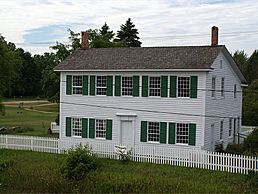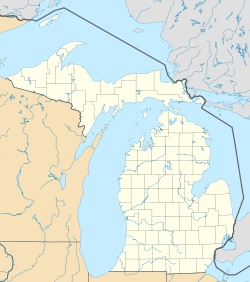Walker Tavern facts for kids
|
Walker Tavern
|
|
 |
|
| Location | 11710 U.S. Route 12 Cambridge Township, Michigan |
|---|---|
| Built | c. 1832 |
| Architectural style | Federal |
| Part of | Cambridge Junction Historic State Park |
| NRHP reference No. | 71000404 |
Quick facts for kids Significant dates |
|
| Added to NRHP | January 25, 1971 |
The Walker Tavern is a very old and important building in Cambridge Township, Michigan. It's located in Lenawee County, Michigan, right on a historic road called U.S. Route 12. This special place was recognized as a Michigan Historic Site in 1958. Later, in 1971, it became the first building in Lenawee County to be added to the National Register of Historic Places. Today, the Walker Tavern is part of the Cambridge Junction Historic State Park. It works as a museum and hosts many different events for visitors.
Contents
History of Walker Tavern
Early Days as a Farmhouse
The Walker Tavern started as a simple farmhouse around 1832. We don't know who designed it, but it was built in the Federal style. This style was popular for buildings in the early days of the United States. The house was built at a very important spot. It was where two major roads met: the old Chicago Road (now U.S. Route 12) and the Monroe Pike (now M-50).
Becoming an Inn and Tavern
At some point, a person named Calvin Snell began running the building as a "tavern." A tavern was a place where travelers could stop for a meal, a drink, and a place to rest. Around 1838, Sylvester and Lucy Walker moved from New York State. They likely started renting the inn and tavern from Mr. Snell.
In 1842, the Walkers bought the building and renamed it the Walker Tavern. It became a very busy place. It served as an inn for people traveling from Monroe to Detroit and then on to Chicago. Back then, a trip by stagecoach from Detroit to Chicago could take five days!
Famous Visitors and Community Hub
Many interesting people stayed at the Walker Tavern. Famous guests included Daniel Webster, a well-known politician, and James Fenimore Cooper, a famous writer. The tavern was more than just a place to sleep and eat. It was also a meeting spot for religious groups and political discussions. It was a central part of the community.
Changes Over the Years
Sylvester Walker ran the tavern until about 1853. Then, he built another similar place, called S. Walker's Hotel, right across the street. In 1865, Francis A. Dewey bought the original Walker Tavern.
Later, in 1921, Frederic Hewitt purchased the tavern. He had a new idea for the old building: he turned it into a museum! This helped preserve its history. In 1965, the Walker Tavern was sold to the Michigan Department of Natural Resources (DNR). The DNR worked to restore the building, making some changes to bring it back to its historic look.
What Walker Tavern Looks Like
The Walker Tavern is a two-story building. It's made of wood and covered with white "clapboard" siding. Clapboard means long, thin boards that overlap each other. The building sits on a small hill.
The main structure is built with strong, hand-cut white oak timbers. These timbers are about eight inches thick! Underneath about half of the building, there's a basement made of "fieldstone." Fieldstone is natural stone found in fields. The original part of the tavern is about 36 feet long and 18 feet wide. Over time, three more sections were added to the back of the building, making it much deeper.



